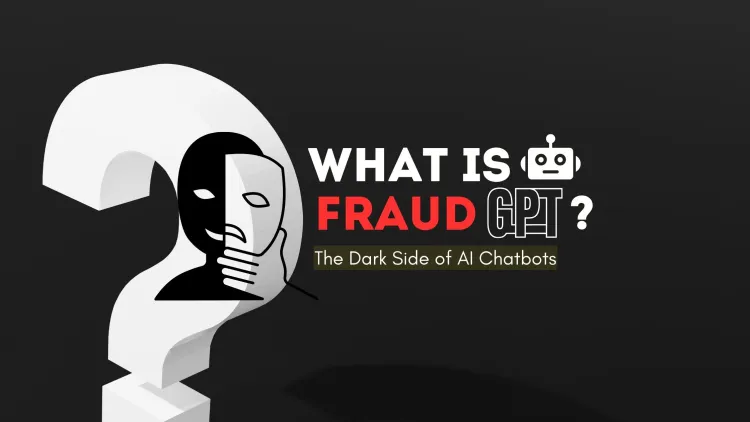What is FraudGPT ? The Dark Side of AI Chatbots
As artificial intelligence (AI) advances, tools like ChatGPT have become crucial for many. However, AI's potential for misuse has led to the emergence of malicious AI-driven tools like FraudGPT. Unlike ChatGPT, FraudGPT is designed to assist cybercriminals in carrying out attacks, offering capabilities like phishing email generation, scam landing page creation, and malicious code generation. Sold on the dark web, FraudGPT operates without restrictions, making cyberattacks more efficient and sophisticated. This blog highlights the threats posed by FraudGPT, its capabilities, and the challenges cybersecurity professionals face in combating AI-driven cybercrime. It also outlines best practices to help safeguard against such threats.

As artificial intelligence (AI) continues to reshape workflows and revolutionize information access, AI-powered chatbots like ChatGPT have become indispensable tools for many. However, this technological advancement has also attracted the attention of cybercriminals, leading to the development of tools like FraudGPT. This blog explores FraudGPT’s capabilities, its implications for cybersecurity, and best practices to stay safe in this evolving landscape.
What Is FraudGPT?
FraudGPT is an AI tool designed to facilitate cyberattacks. Unlike ChatGPT, which has built-in safeguards to prevent misuse, FraudGPT operates without any restrictions. It is sold on the dark web and Telegram, with subscription pricing set at $200 per month or $1,700 annually.
Key Details About FraudGPT:
-
First identified by the Netenrich threat research team in July 2023.
-
Frequently updated, with new AI models introduced every one to two weeks.
-
Marketed as a tool for generating malicious content, including phishing emails, malware, and scam websites.
FraudGPT exemplifies how cybercriminals leverage AI to streamline their operations and increase the sophistication of their attacks.
How FraudGPT Works and Its Capabilities
FraudGPT operates similarly to ChatGPT, featuring an intuitive interface with a chat window and a history of previous interactions. Users simply input prompts, and the AI generates tailored responses.
Key Capabilities of FraudGPT:
-
Phishing Email Generation
-
Creates highly convincing emails by inserting specific details, such as a bank’s name.
-
Suggests where to embed malicious links to increase the likelihood of a successful attack.
-
-
Scam Landing Pages
-
Generates fake websites designed to steal sensitive user information.
-
-
Malicious Code Creation
-
Writes malware and other harmful scripts.
-
-
Vulnerability Identification
-
Helps cybercriminals find security weaknesses to exploit.
-
-
Target Recommendations
-
Provides lists of commonly targeted sites and services, aiding in attack planning.
-
FraudGPT’s Connection to WormGPT
The Netenrich team linked the creator of FraudGPT to another malicious AI tool called WormGPT. Researchers from SlashNext found that WormGPT’s algorithms were trained on large datasets of malware, making it particularly effective for crafting phishing emails and business email compromise (BEC) schemes.
These tools highlight how AI is being weaponized to enhance the efficiency and effectiveness of cyberattacks.
Cybersecurity Challenges in the Age of FraudGPT
The emergence of tools like FraudGPT underscores the urgent need for heightened vigilance in cybersecurity. These tools enable hackers to execute attacks more quickly and effectively, with little technical knowledge required.
Key Challenges:
-
Accelerated Attack Timelines
-
Phishing emails and scam websites can now be generated in seconds.
-
-
Unprecedented Sophistication
-
AI-driven attacks are more convincing and harder to detect.
-
-
Erosion of Trust
-
Increased risks of data breaches and compromised systems due to AI misuse.
-
Best Practices for Cybersecurity Professionals and Enthusiasts
To combat the growing threats posed by FraudGPT and similar tools, individuals and organizations must adopt robust cybersecurity measures. Here are some actionable tips:
-
Stay Informed
-
Keep up with the latest developments in AI-driven cyber threats.
-
-
Enhance Threat Detection Tools
-
Invest in advanced cybersecurity solutions capable of detecting and mitigating AI-generated threats.
-
-
Implement Data Protection Policies
-
Educate employees about the risks of sharing sensitive information online or in tools like ChatGPT.
-
-
Regularly Update Security Protocols
-
Ensure systems and software are always up to date to minimize vulnerabilities.
-
-
Promote Cyber Hygiene
-
Encourage best practices, such as using strong passwords and verifying email authenticity.
-
ChatGPT: Friend or Foe?
While tools like FraudGPT pose significant risks, even legitimate AI systems like ChatGPT can be misused. For example, employees may inadvertently compromise sensitive company data by inputting it into ChatGPT.
Key Risks:
-
Data Leaks
-
A March 2023 ChatGPT bug exposed payment details of premium users.
-
-
Incorrect Information
-
ChatGPT’s responses are not always accurate, which can lead to costly errors, especially in cybersecurity contexts.
-
-
Malware Impersonation
-
Cybercriminals may distribute malware disguised as ChatGPT apps.
-
Conclusion
The rise of FraudGPT is a stark reminder of how rapidly cyber threats are evolving. While AI has immense potential to enhance productivity and innovation, it also provides new avenues for cybercriminals. Staying informed, adopting robust security measures, and using AI tools responsibly are essential steps in safeguarding against these emerging threats. The battle between cybercriminals and cybersecurity professionals will undoubtedly intensify as AI technology continues to advance.
FAQs:
1. What is FraudGPT?
FraudGPT is a malicious AI tool that facilitates cyberattacks, including phishing, scam websites, and malware creation. It is sold on the dark web.
2. How is FraudGPT different from ChatGPT?
Unlike ChatGPT, which has built-in safeguards, FraudGPT operates without restrictions, enabling cybercriminals to launch more sophisticated attacks.
3. What are the key capabilities of FraudGPT?
FraudGPT can generate phishing emails, create scam landing pages, write malicious code, identify vulnerabilities, and recommend attack targets.
4. How does FraudGPT work?
It operates through a chat interface, where users input prompts, and the AI generates tailored responses for malicious purposes.
5. Who is behind FraudGPT?
The creator of FraudGPT is linked to another malicious AI tool called WormGPT, which is trained on large datasets of malware.
6. What are the risks associated with FraudGPT?
FraudGPT enables rapid execution of cyberattacks, increased sophistication of attacks, and a higher likelihood of data breaches and compromised systems.
7. What is WormGPT?
WormGPT is another malicious AI tool used for creating phishing emails and business email compromise (BEC) schemes. It shares a creator with FraudGPT.
8. How can organizations protect themselves from FraudGPT-driven attacks?
Organizations should stay informed about AI-driven threats, invest in advanced threat detection tools, implement strong data protection policies, and regularly update security protocols.
9. What are the challenges posed by AI-powered cyber threats like FraudGPT?
The key challenges include faster attack timelines, increased attack sophistication, and a growing erosion of trust due to more convincing attacks.
10. Can ChatGPT also pose cybersecurity risks?
Yes, ChatGPT can inadvertently leak sensitive data, provide inaccurate information, and be impersonated by cybercriminals to distribute malware.












![Top 10 Ethical Hackers in the World [2025]](https://www.webasha.com/blog/uploads/images/202408/image_100x75_66c2f983c207b.webp)

![[2025] Top 100+ VAPT Interview Questions and Answers](https://www.webasha.com/blog/uploads/images/image_100x75_6512b1e4b64f7.jpg)









